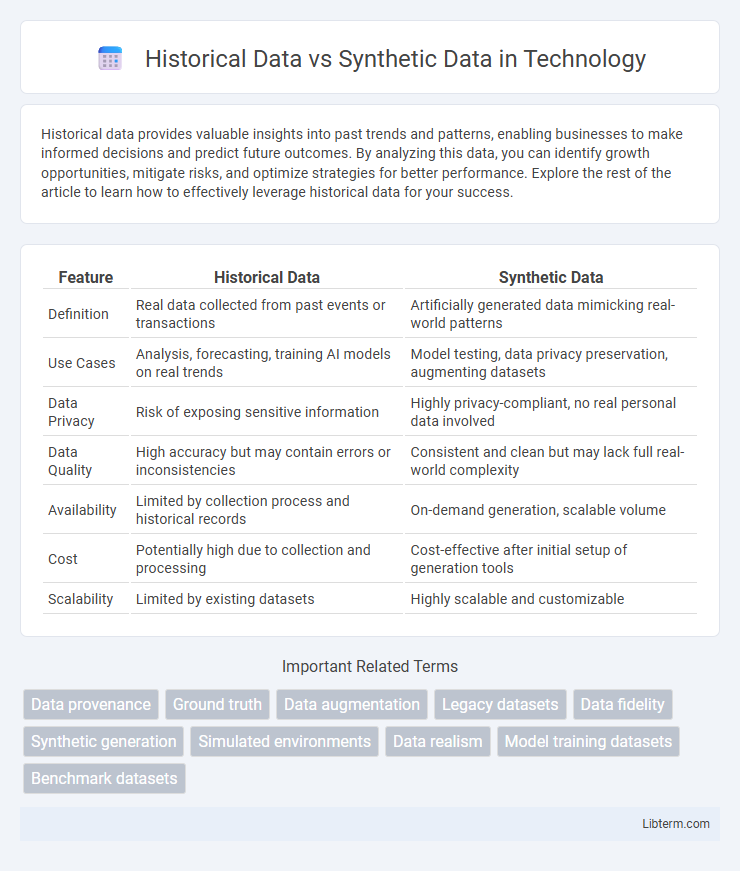Historical data provides valuable insights into past trends and patterns, enabling businesses to make informed decisions and predict future outcomes. By analyzing this data, you can identify growth opportunities, mitigate risks, and optimize strategies for better performance. Explore the rest of the article to learn how to effectively leverage historical data for your success.
Table of Comparison
| Feature | Historical Data | Synthetic Data |
|---|---|---|
| Definition | Real data collected from past events or transactions | Artificially generated data mimicking real-world patterns |
| Use Cases | Analysis, forecasting, training AI models on real trends | Model testing, data privacy preservation, augmenting datasets |
| Data Privacy | Risk of exposing sensitive information | Highly privacy-compliant, no real personal data involved |
| Data Quality | High accuracy but may contain errors or inconsistencies | Consistent and clean but may lack full real-world complexity |
| Availability | Limited by collection process and historical records | On-demand generation, scalable volume |
| Cost | Potentially high due to collection and processing | Cost-effective after initial setup of generation tools |
| Scalability | Limited by existing datasets | Highly scalable and customizable |
Introduction to Historical and Synthetic Data
Historical data consists of real-world records collected from past events, providing authentic insights for analysis, machine learning models, and decision-making. Synthetic data is artificially generated to mimic the statistical properties of historical data without exposing sensitive information, thereby enhancing privacy and expanding datasets. Both types play crucial roles in data science, where historical data offers accuracy and synthetic data supports scalability and confidentiality.
Defining Historical Data
Historical data refers to real-world information collected from past events, transactions, or observations, often stored in databases for analysis and decision-making. This type of data is crucial for identifying trends, patterns, and correlations based on actual occurrences, providing a reliable foundation for forecasting and modeling. Unlike synthetic data, historical data reflects authentic behaviors and conditions, making it essential for validating machine learning models and training algorithms.
What is Synthetic Data?
Synthetic data refers to artificially generated information that mimics the statistical properties and patterns of real-world data without revealing any actual personal or sensitive details. It is created using algorithms such as generative adversarial networks (GANs), simulations, or rule-based models to provide safe, scalable alternatives for training machine learning models. Synthetic data plays a crucial role in overcoming privacy concerns, reducing data collection costs, and enhancing the diversity of datasets for improved AI performance.
Key Differences Between Historical and Synthetic Data
Historical data comprises real-world information collected from past events, reflecting natural patterns, trends, and anomalies inherent to actual occurrences. Synthetic data is artificially generated using algorithms and models to simulate realistic but non-existent data, often used to augment datasets or protect privacy. Key differences include authenticity, with historical data grounded in real outcomes, and flexibility, as synthetic data can be tailored to specific scenarios while avoiding issues of data scarcity and sensitive information exposure.
Advantages of Using Historical Data
Historical data provides authentic, real-world insights derived from actual events, enhancing the accuracy of predictive models. Its richness captures complex patterns and anomalies that synthetic data might overlook, ensuring more reliable analytical outcomes. Using historical data also facilitates compliance with regulatory standards by reflecting true conditions and scenarios encountered in practice.
Benefits of Synthetic Data Generation
Synthetic data generation offers enhanced privacy protection by eliminating the risk of exposing sensitive information inherent in historical data. It enables scalable data creation tailored to specific scenarios, overcoming limitations of sparse or imbalanced historical datasets. Moreover, synthetic data supports improved model training and testing by providing diverse, high-quality samples that enhance machine learning performance across various applications.
Common Applications of Historical Data
Historical data plays a crucial role in sectors like financial forecasting, supply chain management, and healthcare analytics by providing real-world observations used for trend analysis and predictive modeling. In machine learning, it serves as a reliable training dataset to build accurate models that reflect actual behaviors and outcomes. Industries leverage historical data to improve decision-making, optimize operations, and validate artificial intelligence algorithms with authentic past patterns.
Use Cases for Synthetic Data
Synthetic data is ideal for training machine learning models when historical data is scarce, sensitive, or biased, enabling scalable and privacy-preserving solutions. It is extensively used in industries like healthcare for anonymizing patient records, finance for fraud detection simulations, and autonomous vehicle development for creating diverse driving scenarios. Synthetic data enhances model robustness by providing controlled variations that are often absent in real-world historical datasets.
Challenges and Limitations of Both Data Types
Historical data faces challenges such as data quality issues, missing values, and potential biases reflecting past conditions, limiting its generalizability to future scenarios. Synthetic data, while overcoming privacy concerns and data scarcity, often struggles with realism, failing to capture complex real-world patterns, which can reduce model accuracy. Both data types present limitations in scalability, with historical data constrained by availability and synthetic data dependent on sophisticated generation algorithms.
Choosing the Right Data for Your Project
Selecting between historical data and synthetic data depends on your project's objectives, data availability, and privacy requirements. Historical data offers real-world accuracy and context, ideal for predictive modeling and trend analysis, while synthetic data provides customizable, privacy-compliant datasets that can address data scarcity and balance class distributions. Evaluating factors such as data quality, representativeness, and compliance ensures the right choice for model training and validation.
Historical Data Infographic

 libterm.com
libterm.com